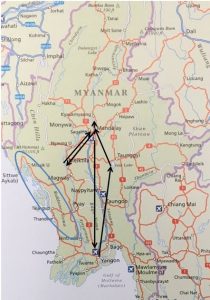David showed us some nice holiday slides, but they needed context and an accompanying map to show us the location of the places visited. Nor was there any mention of the Rohingya troubles. I have therefore consulted the excellent DK Eyewitness Travel book on Myanmar to fill in some gaps, and particularly to correct some of the spellings and decode some of my barely legible blog notes.

David Hague’s route going anticlockwise (just follow the arrows):
Yangon (Rangoon), flight to Helo for Inle Lake and Kalaw Hill Station. Mandalay then north to Mingun, Back to Mandalay then to Bagan via Ayeyarwady River. Manadalay flight to Yangon. Ellipse = Rakhine state (Rohingya troubles)
Myanmar (Burma) borders Bangladesh, India, China, Laos and Thailand. It has towering gilded pagodas, spectacular archeological sites, great beaches, stunning mountains and traditional culture. It was opened up to tourism in 2010 with San Suu Kyi’s success in the general election. My 2016 DK guide adds “the future finally looks bright …after decades of civil war.” Maybe less so now.The Bamars (70 per cent) dominate a diverse minority ethnic population including the Muslim Rohingya (30 per cent). Other constants are Buddhism, and support for the sangha (monkhood). Half a million in claret robes work part time in monasteries from the age of seven. There are some 75,000 nuns.
Tourism just about keeps the economy going.
First stop, Yangon. It’s a mix of (partially rundown) colonial charm and high rise chic five-star living. The Sule pagoda was rebuilt in the 14th and 15th centuries and has a huge octagonal stupa (tower), covered in gold leaf with bamboo scaffolding.
Schwedagon pagoda is Myanmar’s most sacred shrine. The British vandalised it (not unique) but it is now restored. The stupa’s ‘banana bud’ is covered by 13,000 solid gold plates. Just gold leaf below but a 76 carat diamond at the tip of the spire above (Sein Bu). King Tharrawaddy had an 80,000lb bell cast for it in 1841. The ceiling of its pavilion is superbly lacquered and inlaid with mosaic glass
Yangon’s traffic is chaotic, and getting to the other side of the road is a fairly risky business.
Next stop was Heho airport for the Inle Lake. One hundred thousand Intha people live in stilt houses around the lake. Many of them fish with large conical nets, propelling themselves with one leg on the tail of the canoe using the other as a fulcrum on the oar behind. Some of this may be for the benefit of tourists and therefore profitable. Fruit and veg are produced in floating gardens, anchored by bamboo poles. Fried tree ants and crickets are a must. Setting the scene are multiple monasteries, stupas and pagodas (ladies sometimes prohibited), hand-loom fabric and silk production, cigar rolling, boat-building using simple hand tools, girls on motorbikes, melons, sacred cows, mopeds and stray dogs (which don’t bite but rabies wasn’t mentioned). I was puzzled by the lookalike Scots in tartan and the allegiance to Arsenal. I couldn’t quite work out where David had travelled by train apart from being on Nyaungshwe station where there were health and safety issues with exposed mains cables and a train fare hike for foreigners.
You have to experience at least one Burmese rail journey, and the slow train from Shwe Nyaung to Aung Ban (Kalaw) is recommended. Initially built as a century hill station by the British as a summer retreat, it has an agreeable climate and remains full of dilapidated grandeur. Large Edwardian houses are reminiscent of S10. On one of the slides, there was a splendid mock Tudor one that looked very familiar Trekking through terraced fields, tea plantations, forest and subsistence farming communities in the surrounding hills is popular and David clearly enjoyed this.
Overloaded top-heavy cars, fut-fut tractors, horses and carts, a parasol factory and English lessons for would-be tourist guides were David’s first impressions of Mandalay city. The exquisite teak-built Schwenandaw Monastery is one of the few surviving vestiges of the Konbaung Dynasty which preceded the British invasion in 1885
On Mandalay Hill, Kuthodaw Pagoda has a magnificent golden stupa and contains the entire text of the Tipitaka scripture carved on stone tablets (as David put it, the world’s largest book). Amapura, on the outskirts, has more pagodas and the famous U Bein’s teak bridge. It reminded me a bit of the bridge over the River Quai
A cart ride to Inwa saw ancient ruins, brick and gilded stupas, multiple other intact stucco and teak monasteries, all in paddy fields and banana groves. An intact bit of a palace, almost completely destroyed in an earthquake in1839, is Myanmar’s own leaning tower of Pisa.
The Ayeyarwady River runs south and gets increasingly silty (agricultural lifeblood) for 1,250 miles from the Himalayas to the Bay of Bengal, millions depending on it for their livelihood and crop irrigation. Since ancient times it was a strategic link between China and the Indian Ocean.
A gentle chug up-stream from Mandalay for an hour gets you to Mingun where the unfinished giant stupa built by King Bodawpaya is the most striking monument of the whole river.
Bagan is one of Myanmar’s greatest archaeological sites. There are numerous medieval city remnants from Bagan’s empire days from the 11th to 13th centuries, with over 2,000 temples, stupas and monasteries, some of which were seen by David – a superb spectacle rising up from the dusty sand flats.
We saw an impressive aerial view from a great height in a hot air balloon in one of the slides, but shock horror – David confessed it was pinched from the internet.
